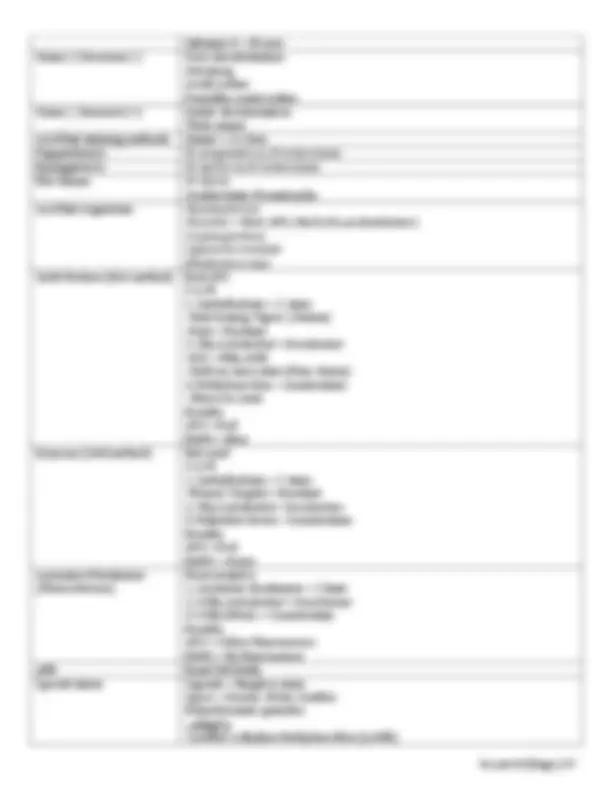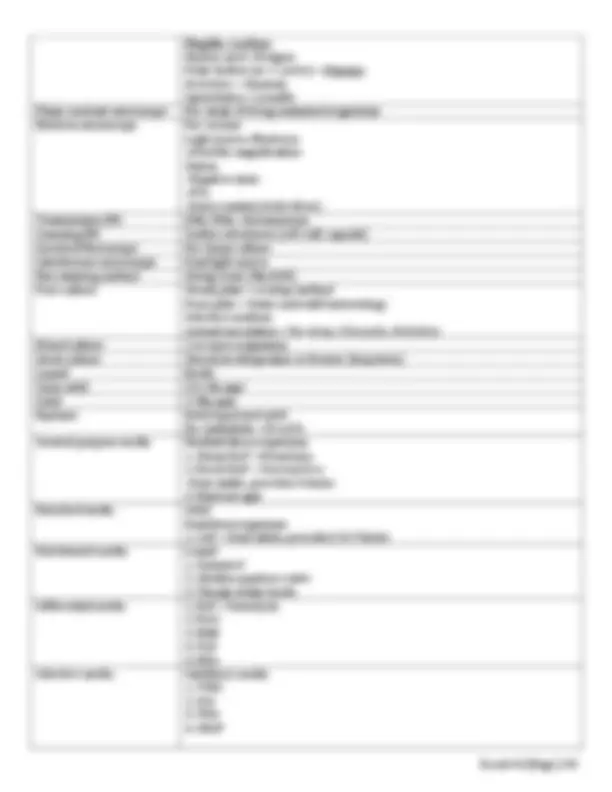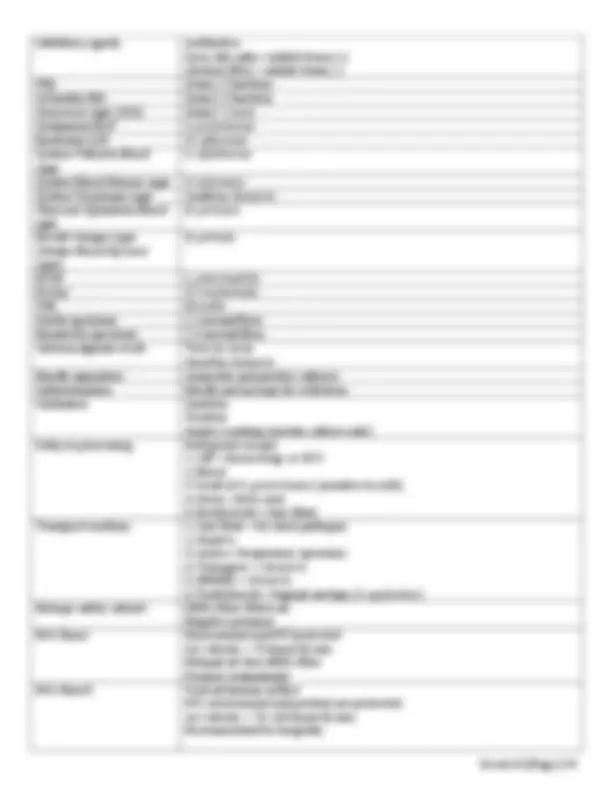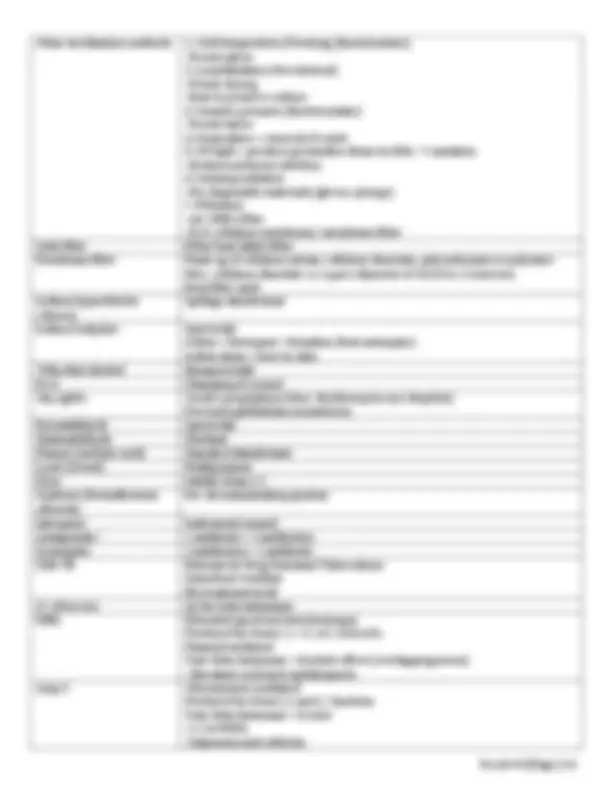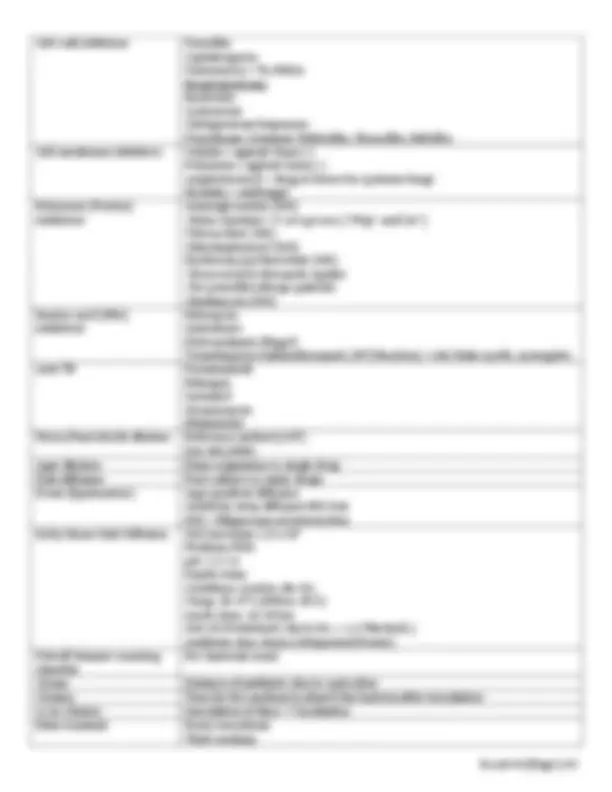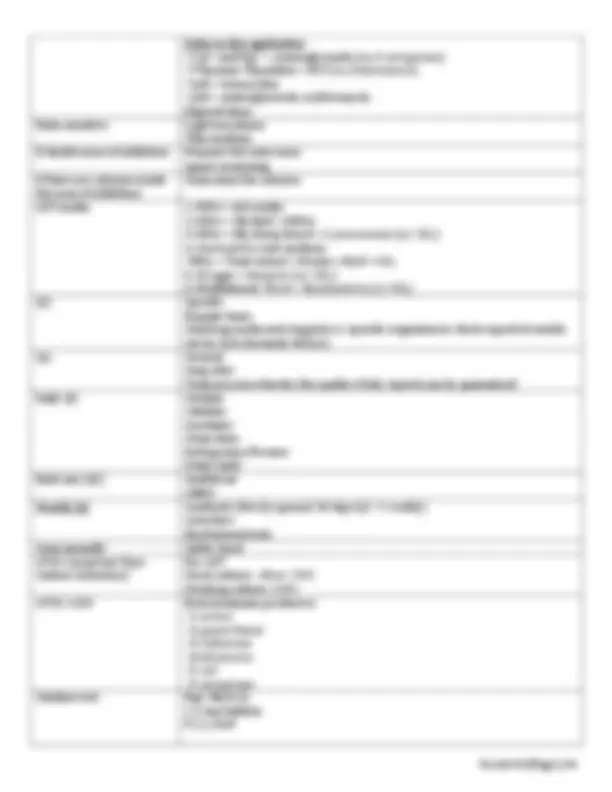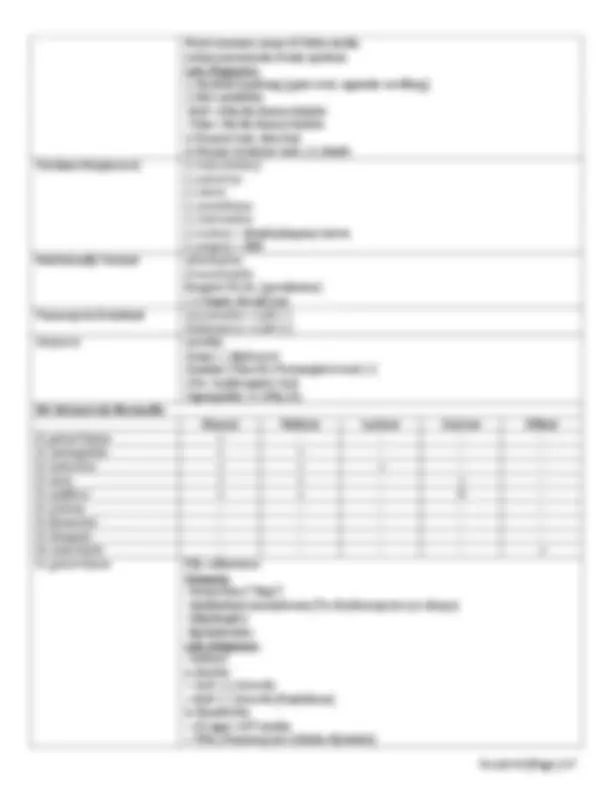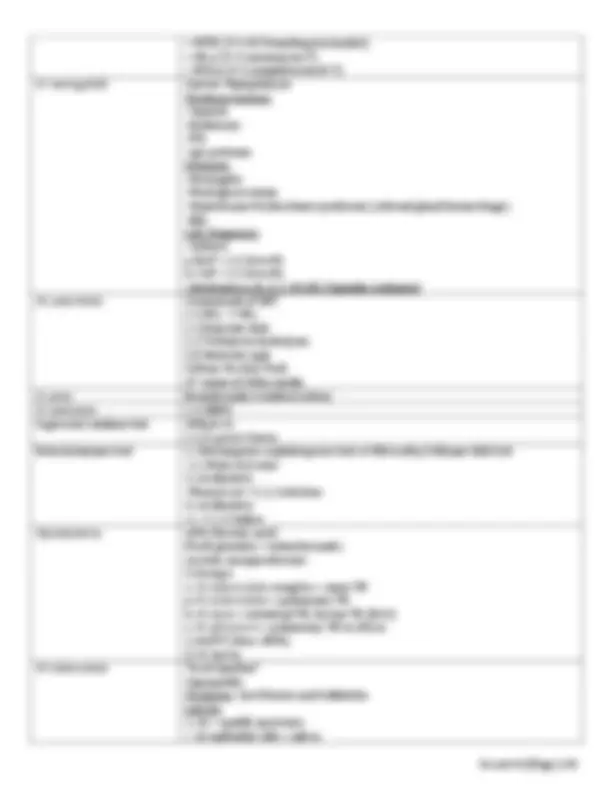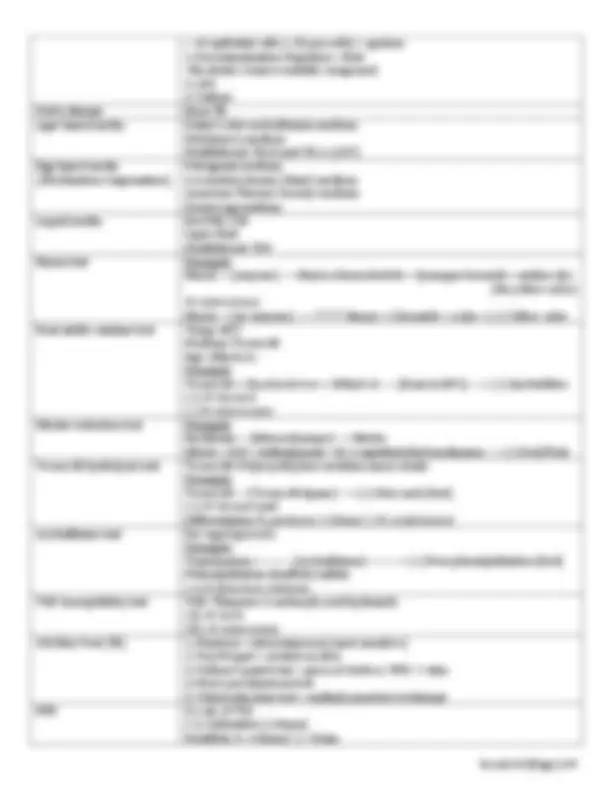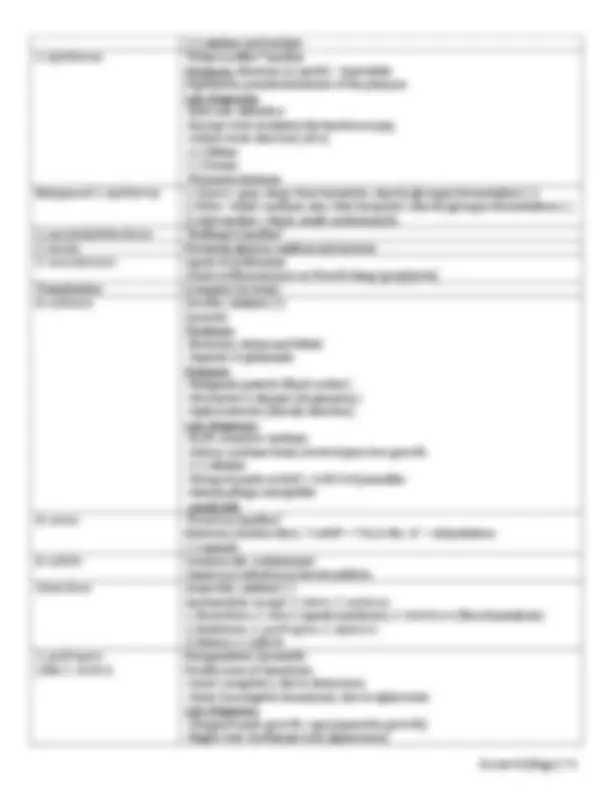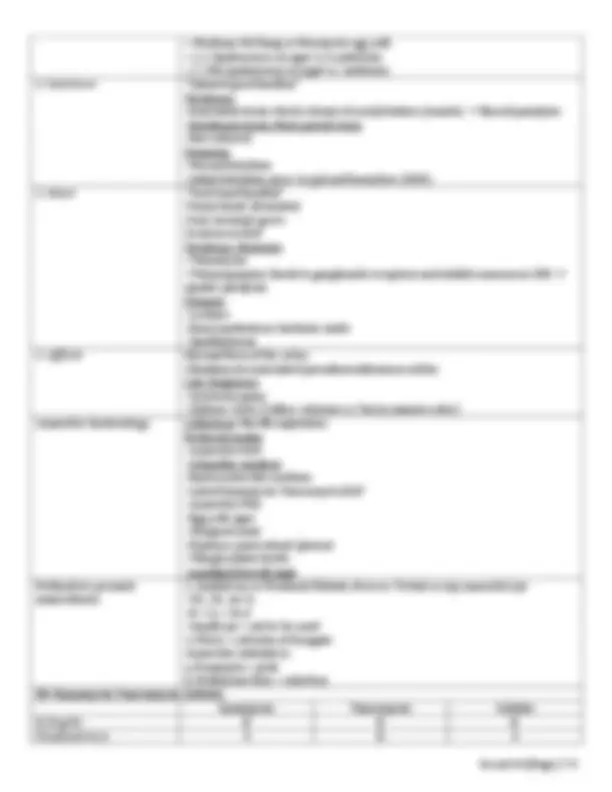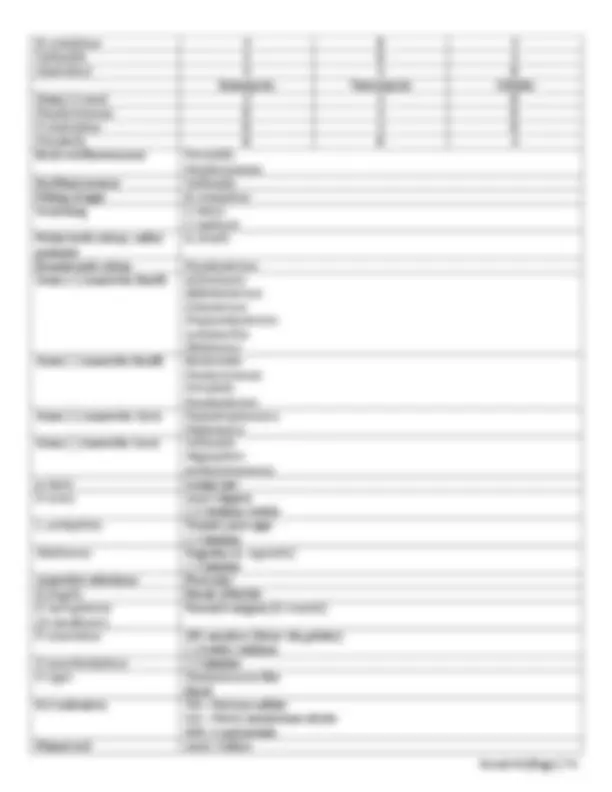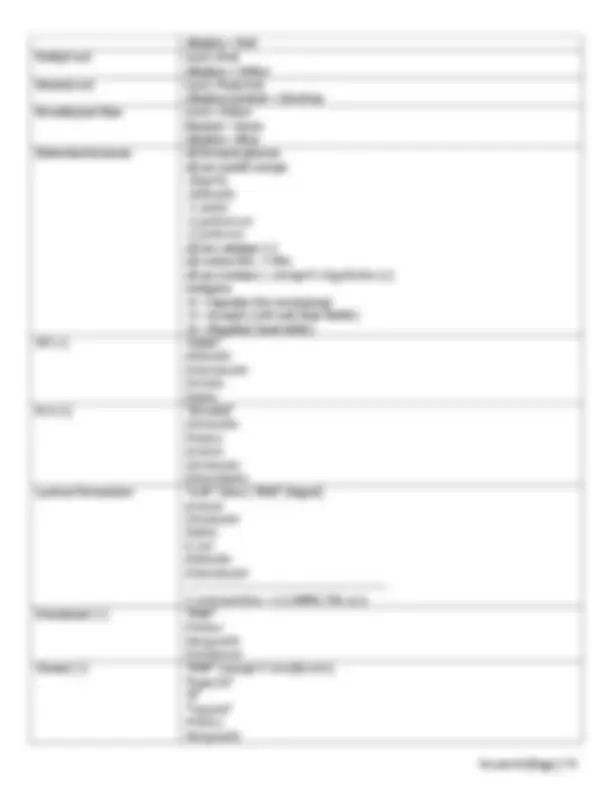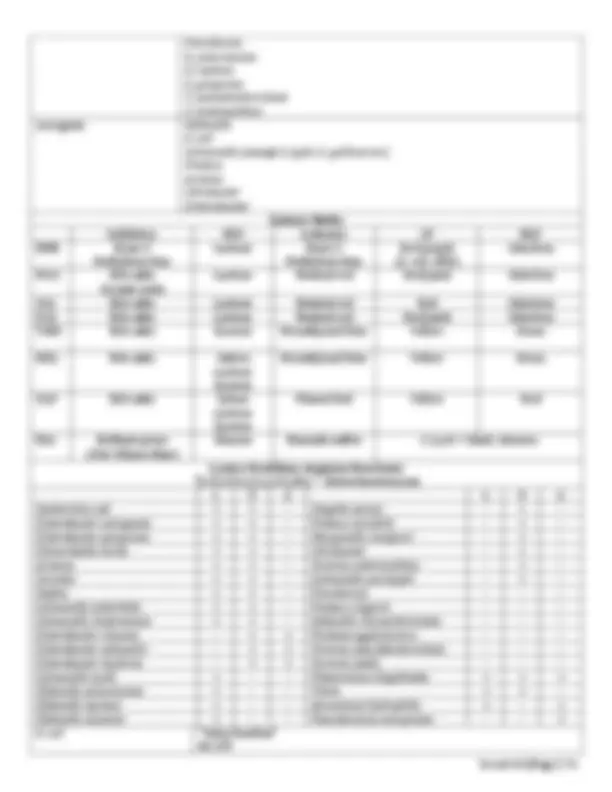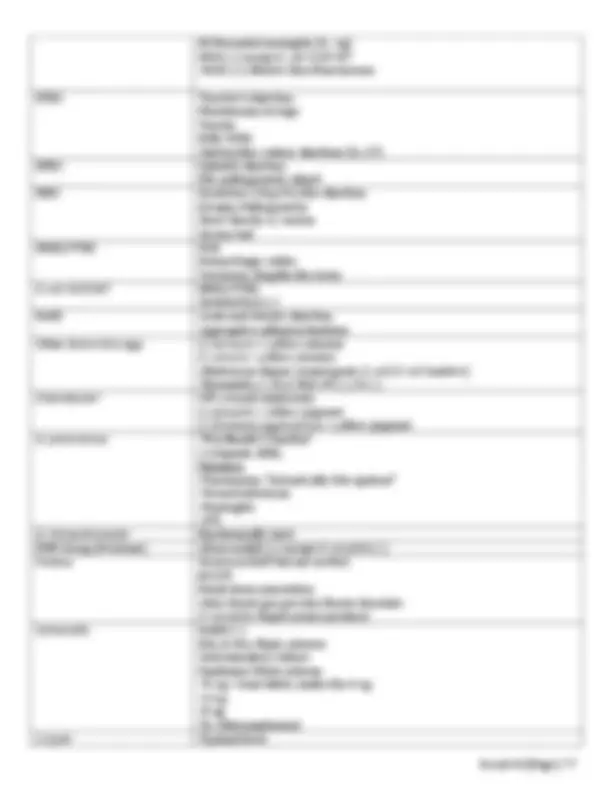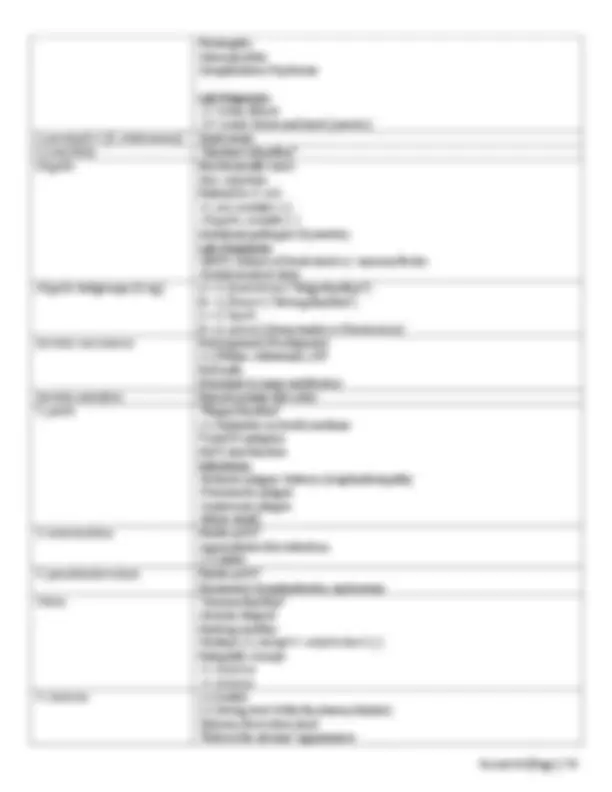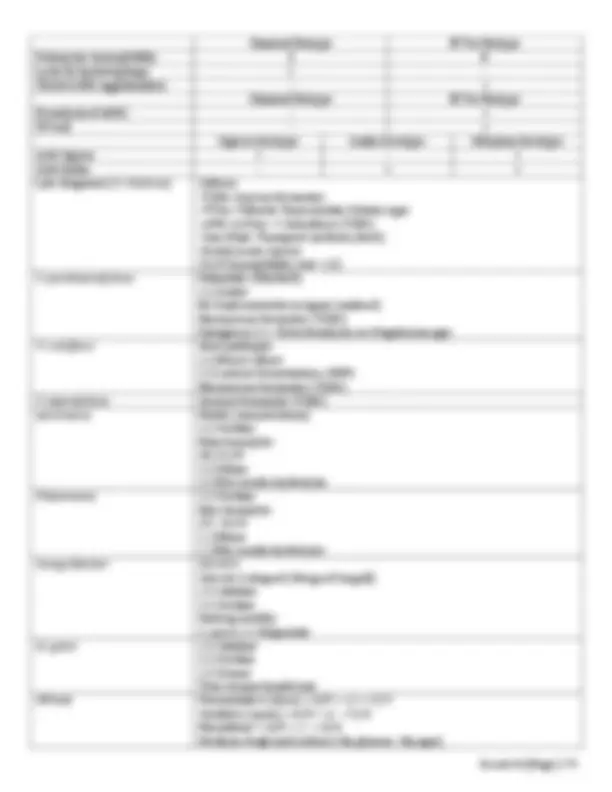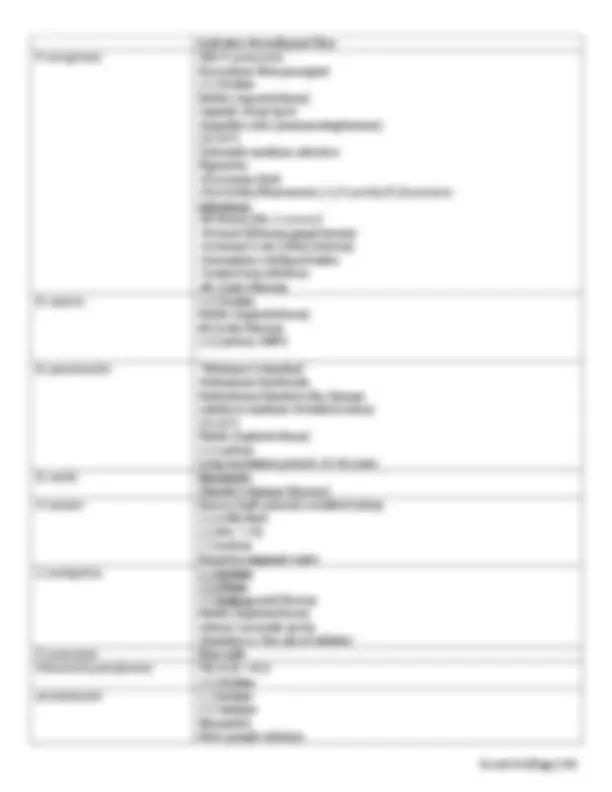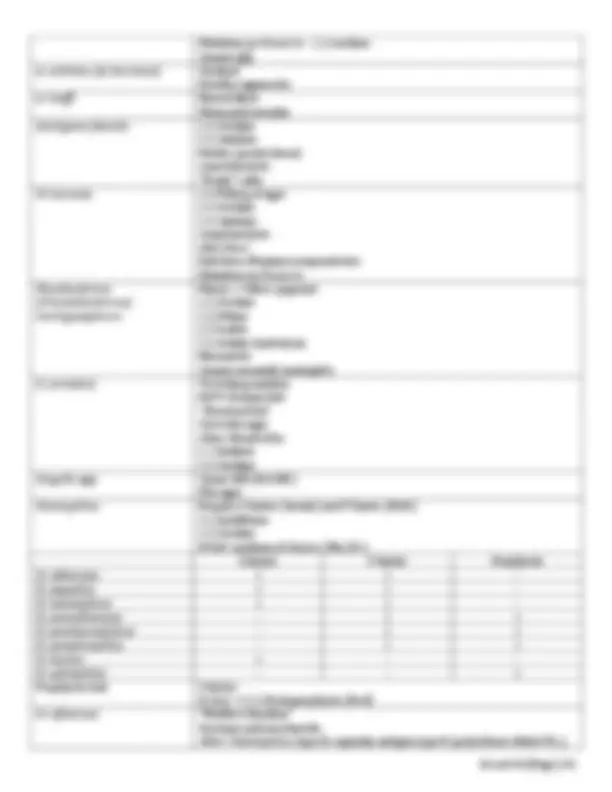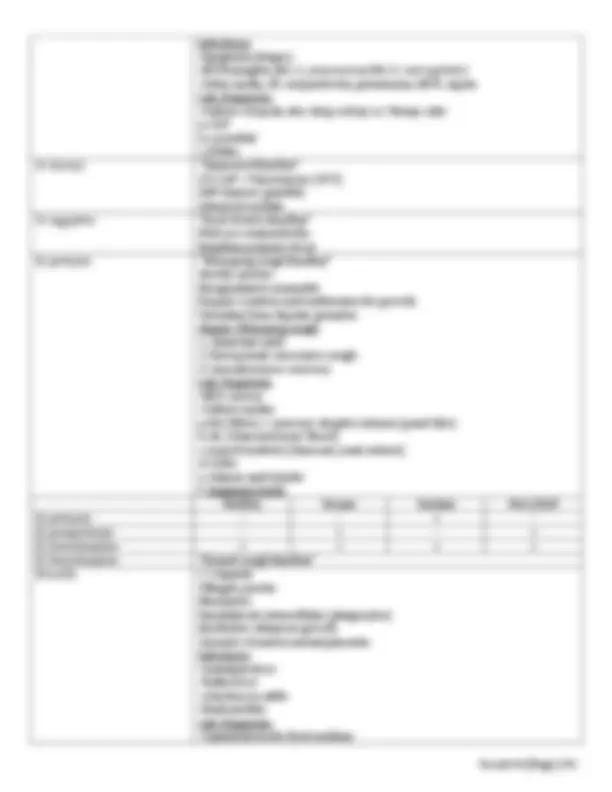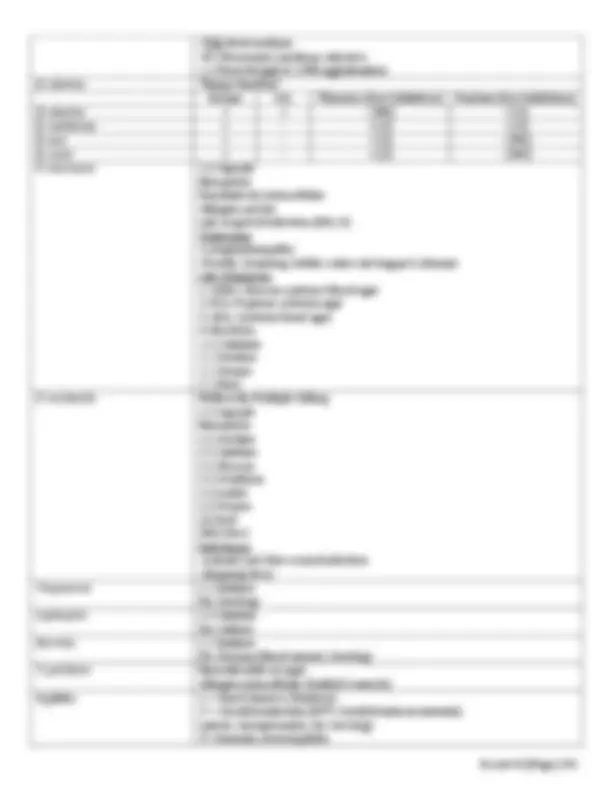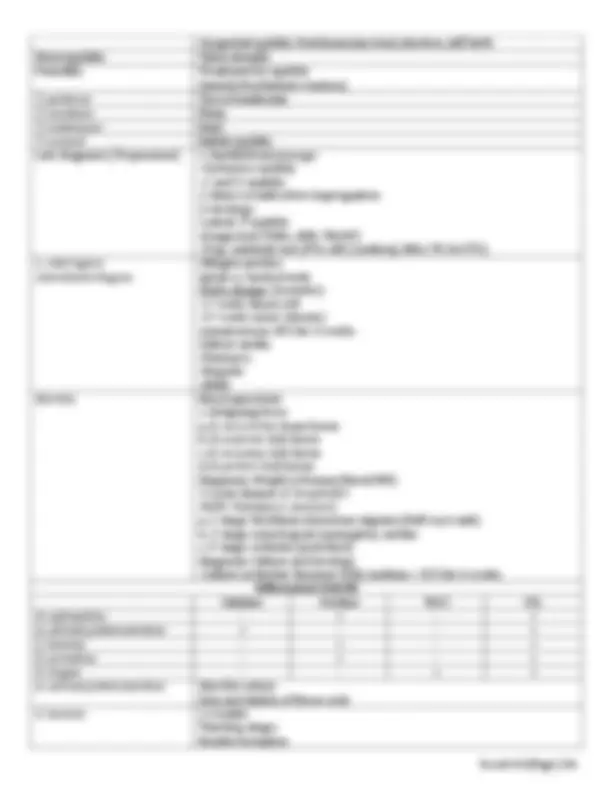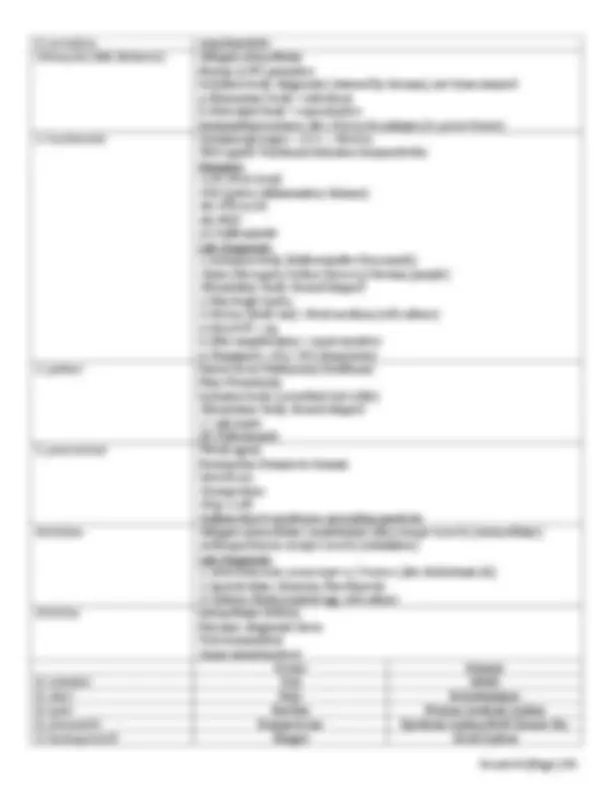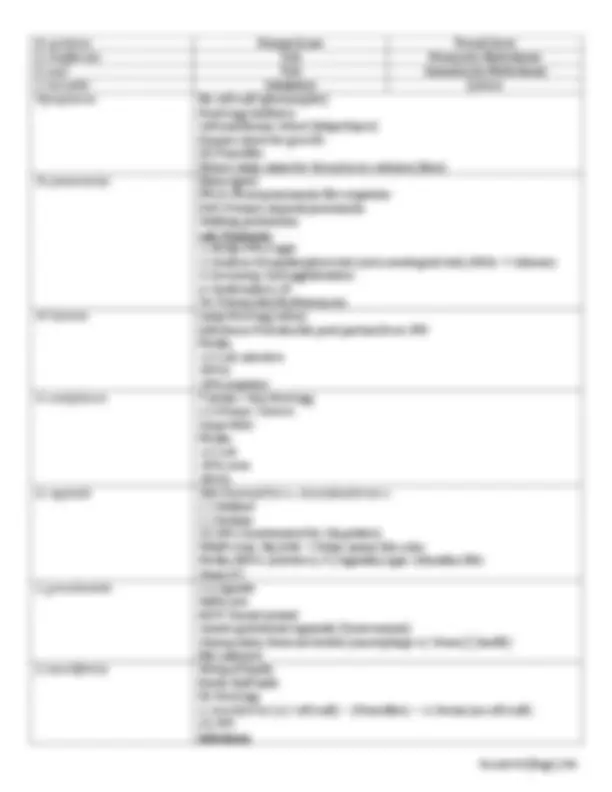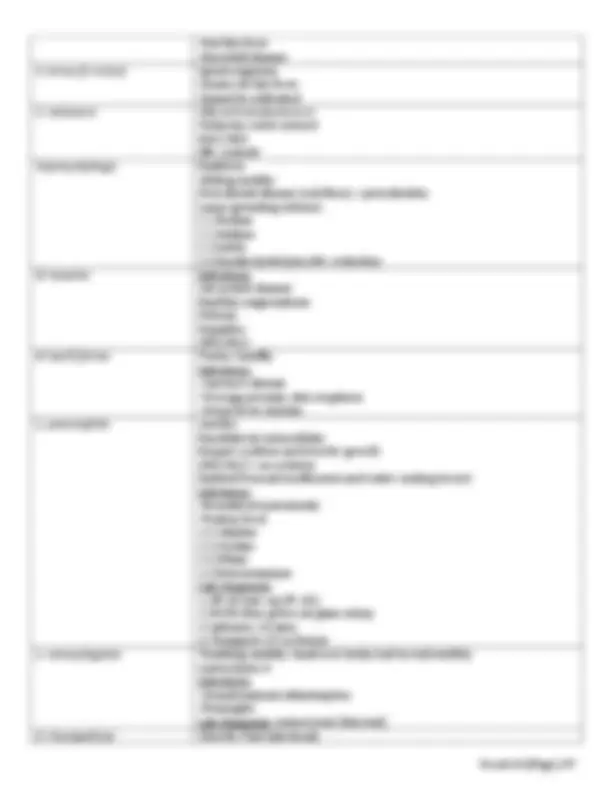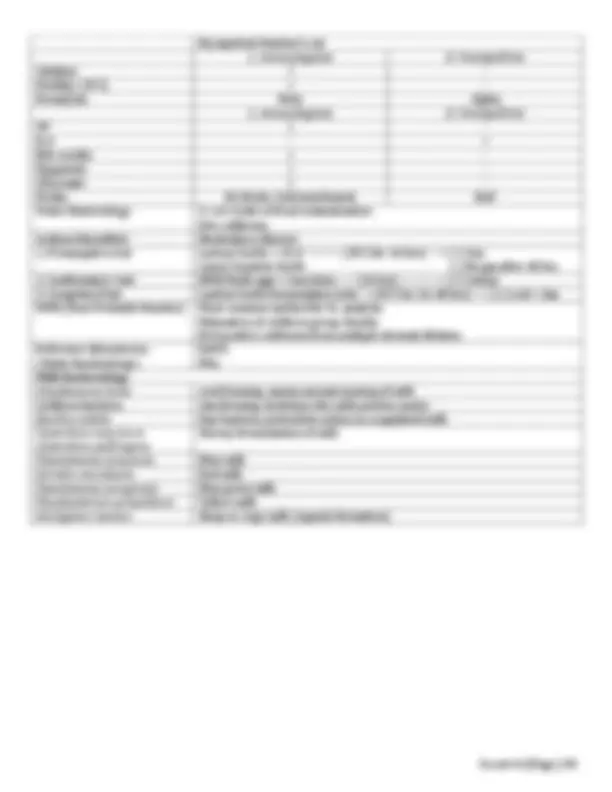Download must know in bacteriology and more Lecture notes Bacteriology in PDF only on Docsity!
MUST TO KNOW IN BACTERIOLOGY
Soap Germicidal L. monocytogenes Catalase (+) 3 C’s: Chicken, Coleslaw, Cheese Chlamydia When delayed: 4’C Freezing: - 20’C BAP Phenotypic Gram (+) colonies: Dry, white, sometimes gray Gram (-) colonies: Gray and moist M. gordonae Destroyed by chlorine DNase test Utilizes 1N HCl LOA test For Gram (+) For nonfermentative For Enterobacteriaceae Na hypochlorite Inactivates HBV (10mins) and HIV (2mins) Inoculating needles Nichrome = F(+) on oxidase test Not longer than 5cm Wire loop 2mm diameter 0.001mL urine 50k CFU/mL Significant for UTI Pregnant C. albicans Lactobacillus Cotton swab Carrier state Lawn a culture Toxic to Neisseria Good for virus Charcoal Removes the toxin inoculated by cotton Phenotype Basis of identifying organisms Gram stain and colonies Stool Not Gram stained PCR Most definitive method of identification Somatic antigen Basis of serotyping Anton van Leeuwenhoek Father of microbiology Microscopist 1 st^ to describe bacteria Robert Koch Germ theory: relationship of organisms to human disease Louis Pasteur Father of Modern Microbiology Ehrlich 1 st^ to use dyes for stain Bacteria Ave. size: 0.4-2μm Reproduction: Binary fission (two-fold increase) Cell wall Peptidoglycan (murein) Protoplast: wall less G(+) Spheroplast: wall less G(-) Gram (+) Thick peptidoglycan Teichoic acid Gram (-) Thin peptidoglycan LPS (Lipid A – exotoxin) Somatic antigen Plasma membrane Site for energy synthesis (ATP) Osmotic/permeability barrier Nucleoid Chromosome: dsDNA Plasmid: Extrachromosomal DNA
Plasmid Carries the antibiotic-resistance gene Drug-resistance Chromosome and plasmid-mediated Metachromatic granules Food reserves Ribosomes Prokaryotic: 70S Eukaryotic: 80S Common pili Bacterial adherence Sex pili Gene transfer ESBL By Gram (-) bacteria Endospores Calcium dipicolinate Bacillus, Clostridium Flagella Monotrichous: one only Amphitrichous: one at both ends Lophotrichous: tuft at one end Peritrichous: all around bacteria (most common) Lactobacillus Aerotolerant anaerobes Autotrophs/Lithotrophs Inorganic compound as source of carbon (CO 2 ) Heterotrophs/ Organotrophs Organic compound as source of carbone (Glucose) Pathogenic bacteria Temperature requirements Psychrophilic: 0-20’C (ref) Mesophilic: 20-40’C (pathogenic) Thermophilic: 40-60’C pH requirement Acidophilic: Lactobacillus acidophilus (Doderlein bacillus) Neutrophilic: pH 7.2-7.6 (optimal) – pathogenic Basophilic: Vibrio (Halophilic) Moisture Humidophilic Salt concentration Halophilic Enterococcus and V. parahaemolyticus Respiration (Aerobic) Glucose CO 2 + H 2 O Kreb’s cycle Electron transport chain Oxidation (Aerobic) Glucose Acid Fermentation (Anaerobic) Glucose Acid/Alcohol Embden-Meyerhoff pathway (glycolysis) Lag phase Adjustment Log/Exponential phase in growth rate (cell division) Susceptible to antimicrobial agents Stationary/plateau phase No net growth Death = Live cells Depletion of nutrients Accumulation of toxic wastes Sporulation Death/Decline phase Death rate Staining Bacteria stain more by basic stains Capsule stain India ink Borris method Nigrosin method Not Gram stained Chlamydia and Rickettsia = intracellular Mycoplasma and Ureaplasma = no cell wall Spirochetes Gram Stain (Hucker’s modification Crystal violet = 1min Gram’s iodine = 1min Acetone-alcohol or 95% ethanol = 30secs-1min
Flagella = Leifson Nucleic acid = Feulgen Polar bodies (ex: Y. pestis ) = Wayson Rickettsia = Gimenez Spirochetes = Levaditi Phase contrast microscope For study of living unstained organisms Electron microscope For viruses Light source: Electrons 100,000x magnification Stains:
- Negative stain
- PTA
- Heavy metals (Gold, Silver) Transmission EM DNA, RNA, chromosomes Scanning EM Surface structures (cell wall, capsule) Inverted Microscope For tissue culture Interference microscope Dual light source Non staining method String’s test (3% KOH) Pure culture Streak plate = overlap method Pour plate = Water and milk bacteriology Selective medium Animal inoculation = for virus, Chlamydia , Rickettsia Mixed culture 2 or more organisms Stock culture Stored at refrigeratior or freezer (long term) Liquid Broth Semi-solid 0.5-1% agar Solid 2 - 3% agar Biphasic Both liquid and solid Ex. Castañeda = Brucella General purpose media Nonfastidious organisms
- Sheep BAP = Hemolysis
- Horse BAP = Haemophilus
- Heat-stable, provides X-factor
- Nutrient agar Enriched media Solid Fastidous organisms
- CAP = Heat-labile, provides X & V factor Enrichment media Liquid
- Selenite F
- Alkaline peptone water
- Thioglycollate broth Differential media 1. BAP = hemolysis
- MAC
- EMB
- XLD
- HEA Selective media Inhibitory media
- TCBS
- SSA
- TMA
- CBAP
Inhibitory agents Antibiotics Dyes, bile salts = inhibit Gram (+) Alcohol (PEA) = inhibit Gram (-) PEA Gram (+) bacteria Columbia CNA Gram (+) bacteria Gonococci Agar (GCA) Gram (-) cocci Gentamicin BAP S. pneumoniae Bacitracin CAP H. influenzae Cystine Tellurite Blood Agar C. diphtheriae Cystine Blood Glucose Agar F. tularensis Cystine Trypticase Agar Confirm: Neisseria Charcoal Cephalexin Blood agar B. pertussis Bordet-Gengou Agar (Potato Blood Glycerol Agar) B. pertusis BCYE L. pneumophila McCoy Cl. trachomatis TSB Brucella Sterile specimen (-) normal flora Nonsterile specimen (+) normal flora Calcium alginate swab Toxic to virus Good for Neisseria Needle aspiration Anaerobic and aerobic cultures Catheterization Needle and syringe for collection Intubation Gastritis Vomitus Gastric washing (aerobic culture only) Delay in processing Refrigerate except:
- CSF = Room temp. or 35’C
- Blood
- Swab of N. gonorrhoeae (sensitive to cold)
- Urine = Boric acid
- Rectal swab = Cary-Blair Transport medium 1. Cary Blair = for stool pathogen
- Stuart’s
- Amies = Respiratory specimen
- Transgrow = Neisseria
- JEMBEC = Neisseria
- Todd-Hewitt = Vaginal carriage ( S. agalactiae ) Biologic safety cabinet HEPA filter: filters air Negative pressure BSC Class I Environment and MT protected Air velocity = 75 linear ft/min Exhaust air thru HEPA filter Product contaminant BSC Class II Vertical laminar airflow MT, environment and product are protected Air velocity = 75-100 linear ft/min Recommended for hospitals
Serologic typing Respiratory specimen Sputum, NPS TB = 3 sputum specimen Media: BAP, MAC, GBAP, BCAP, Amies, Gram stain and Acid fast stain Throat swab Sore throat 2 specimen Media: BAP, MTM, Thioglycollate broth Vaginal, Urethral swab Media: CAP, MTM Gram stain TB culture NALC-NaOH = Gold standard
- NALC = digestion, lyse the mucus
- NaOH = decontamination 6% Oxalic acid = Pseudomonas Centrifuge (4’C) for 15 mins at 3000g Media: LJ, Middlebrook 7H11, 7H10 (AST) Incubate at 37’C for 8 weeks ----(NG)----> Report as (-) If (+), after 2-3 weeks: growth is seen GenPro Genetic Pro DNA test Result 2 hrs Moist heat sterilization 1. Autoclave (sporicidal)
- 121’C at 15 lbs/psi for 15 mins
- Culture media, bandages, gauze
- QC: B. stearothermophilus
- Inspissation (sporicidal)
- 75 - 80’C for 2 hrs on 3 days
- Disinfect and solidify protein containing medium (LJ, Loeffler’s)
- Water is heated from below and slanting surface gets heated
- Tyndallization (sporicidal)
- 100’C for 30mins on 3 days
- Boiling (Nonsporicidal, disinfectant)
- 100’C for 30mins
- Kills vegetative cells only
- Pasteurization (Nonsporicidal, disinfectant)
- Milk
- 63’C for 30mins
- 72’C for 15secs
- Phosphatase: to determine if pasteurization is successful. (+): Not pasteurized Dy heat sterilization 1. Hot air oven (Sporicidal)
- 170 - 180’C for 2 hrs
- Glasswares, cottonswabs, metallic instruments, oils, powders
- QC: B. subtilis
- Incineration (Sporicidal)
- Waste disposal
- Not recommended
- Cremation (Sporicidal)
- Prevents communicable disease
- Flaming (Sporicidal)
- Gas: Ethylene oxide (sporicidal)
- Heat-labile machine instruments
Other sterilization methods 1. Cold temperature/Freezing (Bacteriostatic)
- Lyophilization (Powderized)
- Freeze drying
- Best to preserve culture
- Osmotic pressure (Bacteriostatic)
- Dessication = removal of water
- UV light = produce pyrimidine dimer to DNA mutation
- Reduces airborne infection
- Ionizing radiation
- For disposable materials (gloves, syringe)
- Filtration
- Air: HEPA filter
- H 2 O: cellulose membrane/ membrane filter Seitz filter Filter heat-labile filter Membrane filter Made up of cellulose nitrate, cellulose diacetate, polycarbonate or polyester New: cellulose diacetate w/ a pore diameter of 0.015 to 12 microns Best filter used Sodium hypochlorite (Clorox) Spillage disinfectant Iodine/Iodophor Sporicidal Iodine + Detergent = Betadine (Best antiseptic) Iodine alone = toxic to skin 70% ethyl alcohol Nonsporicidal H 2 O 2 Cleansing of wound 1% AgNO 3 Crede’s prophylaxis (New: Erythromycin eye droplets) Prevents ophthalmia neonatorum Formaldehyde Sporicidal Glutaraldehyde Sterilant Phenol (Carbolic acid) Standard disinfectant Lysol (Cresol) Multipurpose Dyes Inhibit Gram (+) Zephiran (Benzalkonium chloride) For decontaminating sputum Iatrogenic Instrument caused Antagonistic 1 antibiotic > 2 antibiotics Synergistic 2 antibiotics > 1 antibiotic XDR-TB Extensively Drug Resistant Tuberculosis Quinolone resistant No treatment at all H. influenzae QC for beta-lactamase ESBL Extended spectrum beta-lactamase Produced by Gram (-) = E. coli, Klebsiella Plasmid mediated Test: Beta-lactamase = Keyhole effect (overlapping zones)
- Clavulanic acid and cephalosporin Amp C Chromosome mediated Produced by Gram (+) and (-) bacteria Test: Beta-lactamase = D zone
- (+) to MRSA
- Imipenem and cefotixin
Delay in disc application Ca2+^ and Mg2+^ = Aminoglycoside (vs. P. aeruginosa ) Thymine-Thymidine = SXT (vs. Enterococcus ) pH = tetracycline pH = aminoglycoside, erythromycin Expired discs False sensitive Light inoculums Thin medium If double zone of inhibition Measure the outer zone Ignore swarming If there are colonies inside the zone of inhibition Gram stain the colonies AST media 1. MHA = std. media
- MHA + 2% NaCl = MRSA
- MHA + 5% Sheep blood = S. pneumoniae (w/ CO 2 )
- Haemophilus test medium:
- MHA + Yeast extract + Hemin + NAD + CO 2
- GC agar = Neisseria (w/ CO 2 )
- Middlebrook 7H10 = Mycobacteria (w/ CO 2 ) QC Specific Regular basis Checking media and reagents w/ specific organisms to check expected results Set by CLSI (formerly NCCLS) QA General Snap shot Total process whereby the quality of lab. reports can be guaranteed Daily QC Oxidase Catalase Incubator Gram stain Refrigerator/Freezer Water bath Each use (QC) GasPak Jar ONPG Weekly QC Antibiotic (Newly opened: 30 days QC weekly) Autoclave Biochemical tests Semi-annually Safety hood ATCC (American Type Culture Collection) For AST Stock culture: - 20 or - 70’C Working culture: 2-8’C ATCC- 1234 Beta-lactamase producers: _- S. aureus
- N. gonorrhoeae
- H. influenzae
- Enterococcus
- E. coli
- P. aeruginosa_ Catalase test Rgt: 3% H 2 O 2 (+) Gas bubbles F (+): BAP
Coagulase test Rgt: Rabbit EDTA plasma (+) Clot formation after 4hrs F (+): Citrate F (-): Reading result after 6 hrs (Staphylokinase)
- Slide test (Screening) = detects clumping factor/bound coagulase
- Tube test (Confirmatory) = detects free/unbound coagulase Mannitol fermentation Medium: MSA (7.5% NaCl) Indicator: Phenol Red (+) Yellow (-) Red DNase test 1. Toluidine blue (pink zone)/ Methyl green (clear zone)
- HCl precipitation: no pptn. after adding 1N HCl when DNase (+) = pink Novobiocin test Amt.: 5μg (R): <16mm (S): >16mm Modified oxidase test Rgt: tetramethyl-p-phenylenediamine dihydrochloride in dimethylsulfoxide (+) Purple Staphylococcus Pinhead colonies Mod. oxidase (-) Lysostaphin and Furazolidone (S) Ferments sugar Micrococcus Mod. oxidase (+) Lysostaphin and Furazolidone (R) Oxidizes sugar Stomatococcus Mod. oxidase (-) Lysostaphin and Furazolidone (R) S. aureus Virulence factors:
- Protein A (cell wall)
- Leukocidin (Panton-Valentine)
- Exfoliatin (SSS/Ritter’s disease)
- TSST- 1 (Tampons) Identification:
- Staphyloxanthin (Lipochrome): Yellow-orange colony
- (+) Phosphatase, ONPG, Arginine, NO 3 , VP, Gelatin
- (-) PYR Infections:
- Carbuncles, furuncles, folliculitis, cellulitis, impetigo, bacteremia, endocarditis, osteomyelitis S. lugdunensis Slide coagulase (+) PYR (+) S. intermedius Slide coagulase (+) VP (-) Lab. Diagnosis ( Staphylococcus ) Nasal swab: carrier of S. aureus Culture:
- Vogel-Johnson: Black colonies
- Chapman: Black colonies
- Tellurite Glycine: Black colonies
- P agar
- PEA: selective
- Columbia CNA: selective S. epidermidis #1 skin flora Blood culture contaminant
Most common cause of Otitis media Lobar pneumonia: Rusty sputum Lab. Diagnosis:
- Neufeld Quellung (pptn. test, capsular swelling)
- Bile solubility
- BAP: 10% Na desoxycholate
- Tube: 2% Na desoxycholate
- Francis test: skin test
- Mouse virulence test: (+) death Viridans Streptococci S. mitis (mitior) S. salivarius S. uberis S. constellatus S. intermedius S. mutans = dental plaques/caries S. sanguis = SBE Nutritionally Variant Abiotrophia Granulicatella Require Vit. B 6 (pyridoxine) (+) Staph. Streak test Vancomycin Resistant Leuconostoc = LAP (-) Pediococcus = LAP (+) Neisseria Aerobic Gram (-) diplococci Oxidase (Taxo N): Presumptive test (+) CTA: Confirmatory test Capnophilic: 5-10% CO 2 ID: Neissera & Moraxella Glucose Maltose Lactose Sucrose DNase N. gonorrhoeae + - - - - N. meningitidis + + - - - N. lactamica + + + - - N. sicca + + - + - N. subflava + + - V - N. cinerea - - - - - N. flavescens - - - - - N. elongata - - - - - M. catarrhalis - - - - + N. gonorrhoeae Pili: Adherence Diseases:
- Gonorrhea (“Clap”)
- Ophthalmia neonatorum (Tx: Erythromycin eye drops)
- Salphingitis
- Epididymitis Lab. Diagnosis:
- Culture: a. Sterile: = CAP: (+) Growth = BAP: (-) Growth (Fastidious) b. Nonsterile: = GC agar: AST media = TMA (Vancomycin-Colistin-Nystatin)
= MTM (V-C-N-Trimethoprim lactate) = MLA (V-C-Anisomycin-T) = NYCA (V-C-Amphotericin B-T) N. meningitidis Carrier: Nasopharynx Virulence factors:
- Capsule
- Endotoxin
- Pili
- IgA protease Diseases:
- Meningitis
- Meningococcemia
- Waterhouse-Friderichsen syndrome (Adrenal gland hemorrhage)
- DIC Lab. Diagnosis:
- Culture: a. BAP = (+) Growth b. CAP = (+) Growth
- Serotypes: A, B, C, Y, W135 (Capsular Antigens) M. catarrhalis Commensal of URT (+) NO 3 NO 2 (+) Butyrate disk (+) Tributyrin hydrolysis (G) Nutrient Agar Colony: Hockey Puck 3 rd^ cause of Otitis media N. sicca Breadcrumb/wrinkled colony N. lactamica (+) ONPG Superoxol catalase test 30% H 2 O 2 (+) N. gonorrhoeae Beta-lactamase test 1. Chromogenic cephalosporin test or Nitrocefin/Cefinase disk test
- (+) Pink/red color
- Acidimetric
- Phenol red (+) Colorless
- Acidimetric
- I 2 (+) Yellow Mycobacteria AFB (Mycolic acid) Much granules = metachromatic Aerobic nonsporeformer 3 Groups:
- M. tuberculosis complex = cause TB a. M. tuberculosis = pulmonary TB b. M. bovis = intestinal TB, bovine TB (BCG) c. M. africanum = pulmonary TB in Africa
- MOTT (New: NTM)
- M. leprae M. tuberculosis “Koch bacillus” Capnophilic Virulence: Cord Factor and Sulfatides Lab Dx:
- GS = qualify specimen
10 epithelial cells = saliva
Photochromogens (Group I)
- M. marinum (“Of the sea”)
- (+) pyrazinamidase
- (+) urease
- M. asiaticum
- M. simiae - 1 st: Macaca rhesus monkey
- M. kansasii (“Yellow bacillus”)
- (+) Heat-stable catalase
- (+) Tween 80 hydrolysis
- (+) NO 3 reduction
- Pulmonary infection
- #2 isolate Scotochromogens (Group II)
- M. scrofulaceum
- (+) Urease
- Scrofula: cervical lymphadenitis
- M. szulgai
- Photochromogen at 25’C
- Scotochromogen at 35-37’C
- M. gordonae (“Tap water bacillus”)
- M. flavescens
- M. xenopi
- Hot and cold H 2 O taps
- Cornmeal agar: “Bird’s nest” - Optimal growth at 42’C
- (G) 37’C
- (NG) 25’C
- (-) Tellurite reduction
- (-) Catalase
- M. thermoresistible - (G) 52’C Non-photochromogens (Group III) Colony: Cream/buff
- M. terrae-triviale
- (+) Catalase a. M. terrae (“Raddish bacillus”)
- (NG) NaCl b. M. triviale
- (G) NaCl
- M. avium-intracellulare (“Battey bacillus”)
- M. gastri
- M. haemophilum = require hemin (CAP)
- M. ulcerans (Buruli)
- M. malmoense
- M. tuberculosis Rapid Growers (Group IV)
- M. fortuitum-chelonae
- (+) Arylsulfatase
- (G) MAC a. M. fortuitum
- (+) NO 3 reduction
- (+) 5% NaCl
- (+) Iron uptake
b. M. chelonei
- (-) NO 3 reduction
- (-) 5% NaCl
- (-) Iron uptake
- M. smegmatis
- M. phlei (“Hay bacillus”) Growth: 10-21 days Groups I, II, III (Runyon’s Classification) Growth: 3-7 days Group IV (Rapid growers) AFB Grading (National Standard) CDC Method to Report AFB 0 No AFB/300 fields 0 0 AFB/field +/- 1 - 9 AFB/100 fields +/- 1 - 2 AFB/300 fields 1+ 10 - 99 AFB/100 fields 1+ 1 - 9 AFB/100 fields 2+ 1 - 10 AFB/field in at least 50 fields 2+ 1 - 9 AFB/10 fields 3+ >10 AFB/field in at least 20 fields 3+ 1 - 9 AFB/field -- ------------------------------------------------------------- 4+ >9 AFB/field BACTEC 460 Middlebrook 7H Principle: RIA (^14) C Palmitic acid + organisms ----------> 14 CO 2 (+): >10 growth index Mycobacteria Growth Indicator test (MGIT) Fluorometric based O 2 consumption = Fluorescence BACTEC 12B + NAP (Growth inhibition test) Rgt: p-nitroacetylamino-beta-hydroxypropiophenone (NAP) (NG) = (+) M. tuberculosis M. leprae Cigarette-packet/picket-fence Not cultivable in agar Can hydrolyze DOPA Tropism to peripheral nerves Tx: Dapsone Lepromatous Leonine face (-) Lepromine AFB Tuberculoid (+) Lepromine AFB Lab. Diagnosis (Leprosy) Specimen: Ear lobe, nasal scraping Culture: Foot pads of Armadillo Stain: Fite Faraco M. genavensi Disseminated infection in AIDS BACTEC (+) M. paratuberculosis Crohn’s disease Rhodococcus equi Pleomorphic (rod-cocci) (+) pink colonies Nocardia Partially acid fast (Mod. AFS: H 2 SO 4 ) (+) Urease Cause pneumonia N. asteroides = casein hydrolysis (-) N. brasiliensis = casein hydrolysis (+) Corynebacteria Pleomorphic Club shape: X, Y, V, L (Chinese characters) Palisade appearance: diphtheroids Nonmotile, nonsporeforming, nonencapsulated
= Medium: McClung or Neomycin egg yolk = (+) Opalescence on agar w/o antitoxin = (-) No opalescence on agar w/ antitoxin C. botulinum “Canned-good bacillus” Virulence:
- Heat labile toxin: block release of acetylcholine (muscle) flaccid paralysis
- Botulinum toxin: Most potent toxin
- Not cultured Diseases:
- Wound botulism
- Infant botulism: grow in gut and honeybee (SIDS) C. tetani “Tack head bacillus” Tennis head, drumstick Oval, terminal spore Swarms on BAP Virulence: Exotoxin
- Tetanolysin
- Tetanospasmin: binds to ganglioside receptors and inhibit neurons in CNS spastic paralysis Disease:
- Lockjaw
- Risus sardonicus: Sardonic smile
- Opisthotonus C. difficile Normal flora of the colon Clindamycin-associated pseudomembranous colitis Lab. Diagnosis:
- Cytotoxin assay
- Culture: CCFA (Yellow colonies w/ horse manure odor) Anaerobic bacteriology Collection: Needle aspiration Reduced media:
- Anaerobic BAP
- Schaedler medium
- Bacteroides bile medium
- Laked Kanamycin-Vancomycin BAP
- Anaerobic PEA
- Egg yolk agar
- Chopped meat
- Peptone yeast extract glucose
- Thioglycollate broth
- Lombard Dowell Agar Methods to promote anaerobiosis
- GasPak Jar or Mcintosh Fildesh, Brewer, Torbal or any anaerobic jar
- CO 2 , N 2 , no O 2
- H + O 2 = H 2 O
- Candle jar = not to be used
- PRAS = roll tube of Hungate Anaerobic indicators: a. Resazurin = pink b. Methylene blue = colorless ID: Kanamycin Vancomycin Colistin Kanamycin Vancomycin Colistin B. fragilis R R R Fusobacterium S R S
B. ureolyticus S R S Veillonella S R S Clostridium S S R Kanamycin Vancomycin Colistin Gram (+) cocci S S R Porphyromonas R S R P. anaerobius R S R Prevotella R R S Brick red fluorescence Prevotella Porphyromonas Red fluorescence Veillonella Pitting of agar B. ureolyticus Swarming C. tetani C. septicum Molar tooth colony, sulfur granules A. israelii Breadcrumb colony Fusobacterium Gram (+) Anaerobic Bacilli Actinomyces Bifidobacterium Eubacterium Propionebacterium Lactobacillus Mobiluncus Gram (-) Anaerobic Bacilli Bacteroides Porphyromonas Prevotella Fusobacterium Gram (+) Anaerobic Cocci Peptostreptococcus Peptococcus Gram (-) Anaerobic Cocci Veillonella Megasphera Acidaaminococcus A. bovis Lumpy jaw P. acnes Acne vulgaris (+) Catalase, Indole L. acidophilus Tomato juice agar (-) Catalase Mobiluncus Vaginitis ( G. vaginalis ) (-) Catalase Anaerobic infections Foul odor B. fragilis Needs 20% bile F. necrophorum ( F. moriferum ) Vincent’s angina ( B. vincenti ) P. anaerobius SPS sensitive (Neut: 1% gelatin) (-) Indole, Catalase P. asaccharolyticus (-) Catalase P. niger Staphylococcus- like Black H 2 S indicators TSI = Ferrous sulfate LIA = Ferric ammonium citrate SIM = Lead acetate Phenol red Acid = Yellow

